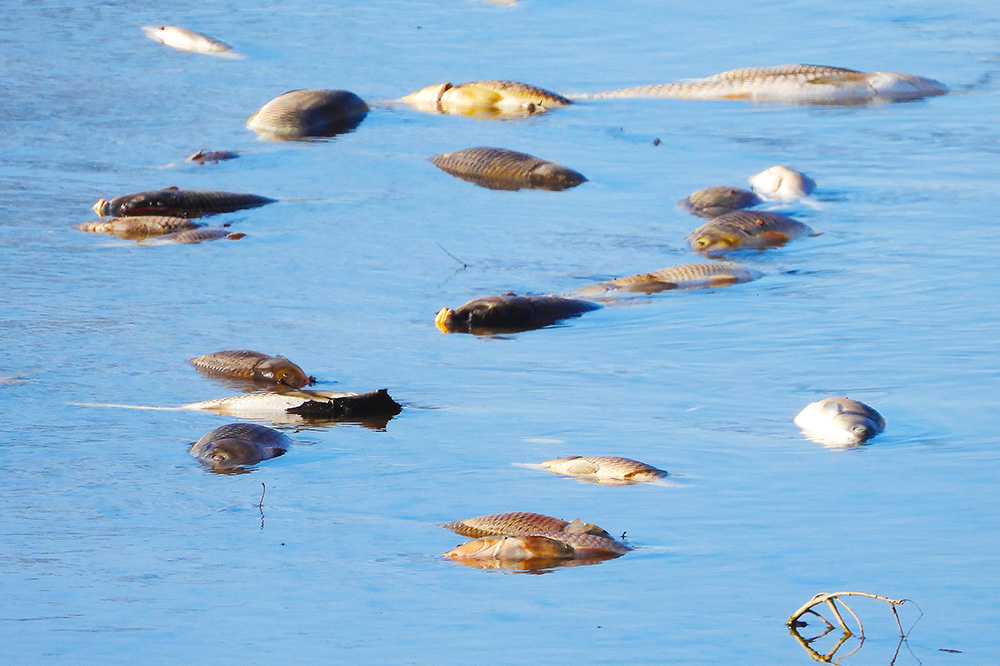Understanding the true scope of the Nishnabotna fertilizer spill
posted
by Alicia Vasto on Wednesday, April 3, 2024
This guest column by IEC Water Program Director Alicia Vasto was originally published in the Cedar Rapids Gazette on April 2, 2024.
A recent fertilizer spill at NEW Cooperative in southwest Iowa that entered the East Nishnabotna River killed approximately 750,000 fish over a 60 mile stretch of river. According to reporting from the Iowa Capital Dispatch, it is the largest fish kill in Iowa in a decade and the fifth largest in our state’s history.
This story should be national news, but maybe you haven’t even heard about it from your local news outlet because it’s on the other side of the state, or perhaps because spills that enter a river or waterway seem to happen almost every other day here in Iowa.
According to the Iowa Department of Natural Resources (DNR) fish kill database, there have been 64 fish kills in the past decade due to fertilizer, manure, pesticides, or other chemicals. Of the 58 events with fish kill estimates, over 1.1 million fish were killed.
But this one fish kill in the East Nishnabotna is unique. The size of the fish kill is near the magnitude of all the fish kills over the past decade combined. The damage is almost nuclear – nothing living in the river for 60 miles, not to mention the bugs, worms, turtles, birds, snakes, and other wildlife on the shoreline or in the soil that rely on that river for food and water.

Photo courtesy of Iowa Capital Dispatch and Tracy Lovett
The fact that this can even happen is incomprehensible. How can we allow fertilizer to be stored in a way that one single leak or open valve could result in the annihilation of an entire river ecosystem for 60 miles? The total death of a large river’s entire population of not just fish, but mussels, frogs, snakes, and other aquatic life? It should not be allowed. And there should be penalties commensurate with the damage.
The Iowa Capital Dispatch reported that the estimated value of the small fish is $85,000 and the value of the catfish is $115,000. What about the value of the river as habitat for the future? What about the cumulative damage these kinds of incidents and industrial agriculture as a system do to Iowa’s environment, wildlife, and overall livability? And what about the risk to the humans that live near this river who could be drinking contaminated well water or exposed in other ways?
So far, there is no word on penalties or fines, but DNR fines are capped at $10,000 unless the department pursues further restitution through the courts. (The version of this column submitted to the Gazette and published on 4.2.2024 incorrectly reported a $6,000 fine had been issued.) Will the DNR pursue more than the maximum fine? Will residents, landowners, and lawmakers register the scope of this incident and demand accountability from the company responsible for this annihilation, or will they let it go and let NEW Coop continue ‘business as usual’?
In many ways, the values of our waterways and natural places cannot be estimated or given a dollar value. Many of the services our environment provides can be measured in dollars – ecologic and economic studies are building models to calculate what are known as “ecosystem services” such as resilience to natural disasters, pollination of food crops, etc. But there is inherent value in our natural places that we don’t need scientific modeling to know exists.
I know many Iowans like myself feel, without needing to see the numbers, that our environment is critically damaged and getting worse, and it doesn’t seem as though anyone with the power to make change is paying attention or calling for a different path. It feels more and more like we have lost the natural integrity of our state and are truly a sacrifice state for industrial agriculture. Our state leaders seem to prefer it that way.
My job as an advocate for Iowa’s waters often requires me to build enthusiasm and provide optimism that invites others to join the fight for Iowa’s environment and contact their elected officials about these issues. But incidents like these leave me feeling heartbreak and despair. All I can say is that this is wrong, we all know it, and we must and we will continue to call it out and demand better.
- clean water
- nitrate pollution
- water quality